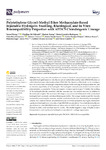Poly(ethylene Glycol) Methyl Ether Methacrylate-Based Injectable Hydrogels: Swelling, Rheological, and In Vitro Biocompatibility Properties with ATDC5 Chondrogenic Lineage

Use este enlace para citar
http://hdl.handle.net/2183/38321
Excepto si se señala otra cosa, la licencia del ítem se describe como Creative Commons License Attribution-NonCommercial 4.0 International (CC BY-NC 4.0)
Colecciones
- Investigación (EPEF) [590]
Metadatos
Mostrar el registro completo del ítemTítulo
Poly(ethylene Glycol) Methyl Ether Methacrylate-Based Injectable Hydrogels: Swelling, Rheological, and In Vitro Biocompatibility Properties with ATDC5 Chondrogenic LineageFecha
2023-12-07Cita bibliográfica
Farrag, Y.; Ait Eldjoudi, D.; Farrag, M.; González-Rodríguez, M.; Ruiz-Fernández, C.; Cordero, A.; Varela-García, M.; Torrijos Pulpón, C.; Bouza, R.; Lago, F.; et al. Poly(ethylene Glycol) Methyl Ether Methacrylate-Based Injectable Hydrogels: Swelling, Rheological, and In Vitro Biocompatibility Properties with ATDC5 Chondrogenic Lineage. Polymers 2023, 15, 4635. https://doi.org/10.3390/polym15244635
Resumen
[Abstract] Here, we present the synthesis of a series of chemical homopolymeric and copolymeric injectable hydrogels based on polyethylene glycol methyl ether methacrylate (PEGMEM) alone or with 2-dimethylamino ethyl methacrylate (DMAEM). The objective of this study was to investigate how the modification of hydrogel components influences the swelling, rheological attributes, and in vitro biocompatibility of the hydrogels. The hydrogels’ networks were formed via free radical polymerization, as assured by 1H nuclear magnetic resonance spectroscopy (1H NMR). The swelling of the hydrogels directly correlated with the monomer and the catalyst amounts, in addition to the molecular weight of the monomer. Rheological analysis revealed that most of the synthesized hydrogels had viscoelastic and shear-thinning properties. The storage modulus and the viscosity increased by increasing the monomer and the crosslinker fraction but decreased by increasing the catalyst. MTT analysis showed no potential toxicity of the homopolymeric hydrogels, whereas the copolymeric hydrogels were toxic only at high DMEAM concentrations. The crosslinker polyethylene glycol dimethacrylate (PEGDMA) induced inflammation in ATDC5 cells, as detected by the significant increase in nitric oxide synthase type II activity. The results suggest a range of highly tunable homopolymeric and copolymeric hydrogels as candidates for cartilage regeneration.
Palabras clave
Biopolymers
Injectable hydrogels
PEGMEM
DMAEM
Biocompatibility
Injectable hydrogels
PEGMEM
DMAEM
Biocompatibility
Versión del editor
Derechos
Creative Commons License Attribution-NonCommercial 4.0 International (CC BY-NC 4.0)
ISSN
2073-4360






